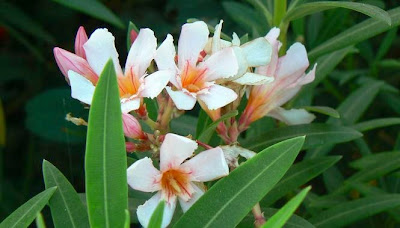Type of Flower
Digitalis:
Digitalis is a genus of about 20 species of herbaceous perennials, shrubs, and biennials commonly called foxgloves. This genus was traditionally placed in the figwort family Scrophulariaceae, but recent phylogenetic research has placed it in the much enlarged family Plantaginaceae.This genus is native to western and southwestern Europe, western and central Asia, Australasia and northwestern Africa. The scientific name means "finger-like" and refers to the ease with which a flower of Digitalis purpurea can be fitted over a human fingertip. The flowers are produced on a tall spike, are tubular, and vary in colour with species, from purple to pink, white, and yellow. The best-known species is the common foxglove, Digitalis purpurea. This biennial plant is often grown as an ornamental plant due to its vivid flowers which range in colour from various purple tints through various shades of light gray, and to purely white. The flowers can also possess various marks and spottings.
The first year of growth of the common foxglove produces only the stem with its long, basal leaves. During the second year of the plant's life, a long, leafy stem from 50 to 255 centimeters tall grows atop the roots of healthy plants.
The larvae of the moth the "foxglove pug" consume the flowers of the common foxglove for food. Other species of Lepidoptera eat the leaves, including lesser yellow underwing. The term digitalis is also used for drug preparations that contain cardiac glycosides, particularly one called digoxin, extracted from various plants of this genus.
Other common names, purple foxglove, witches' gloves, dead men's bells, thimbles, fairy cap, fairy glove, fairy thimbles, fairy finger, fairybells, dog's-finger, finger flower, lady's-glove, lady's-finger, lady 's-thimble, popdock, flapdock, flopdock, lion's-mouth, rabbit's-flower, cottagers, throatwort, Scotch mercury, bloody fingers, virgin's glove.
Foxglove, also called Digitalis purpurea, is a common biennial garden plant that contains digitoxin, digoxin, and other cardiac glycosides. These are chemicals that affect the heart. Digitalis is poisonous; it can be fatal even in small doses. It was the original source of the drug called digitalis.
Originally introduced into this America from Europe as an ornamental garden plant, foxglove may now be found wild in a few localities in parts of Oregon, Washington, and West Virginia, having escaped from cultivation and assumed the character of a weed. It occurs along roads and fence rows, in small cleared places, and on the borders of timberland.
Although the leaves of the upper stem are particularly potent, with just a nibble being enough to cause death. The upper leaves of the stem are more dangerous than the lower leaves. Foxglove is most toxic just before the seeds ripen. It tastes spicy hot or bitter and smells slightly bad. This plant is so poisonous that ingesting only .5 gram dried or 2 grams of fresh leaf is enough to kill a person. Even inhaling the pollen can cause reactions to some people.
There have been instances of people confusing the digitalis with the harmless comfy plant (which is often brewed into a tea) with fatal consequences. Other fatal accidents involve children drinking the water in a vase containing digitalis plants. Drying does not reduce the toxicity of the plant. The plant is toxic to animals including all classes of livestock, as well as cats and dogs.
A single foxglove plant can produce over a million seeds, it does sow itself prolifically in unexpected places. And, being a biennial, it only produces a low cluster of leaves during its first year.
If you have small children, please don't plant them in your garden. Just because they don't bother you, doesn't mean they won't bother your child or even your friends visiting your home. Remember that even inhaling the pollen can cause serious reactions to some people. It is better to be safe than sorry!
I still think that Foxglove Flowers are beautiful, but now I just view them as I drive down the road.
References:http://en.wikipedia.org/wiki/Digitalis
http://whatscookingamerica.net/Information/Foxglove.htm

















































